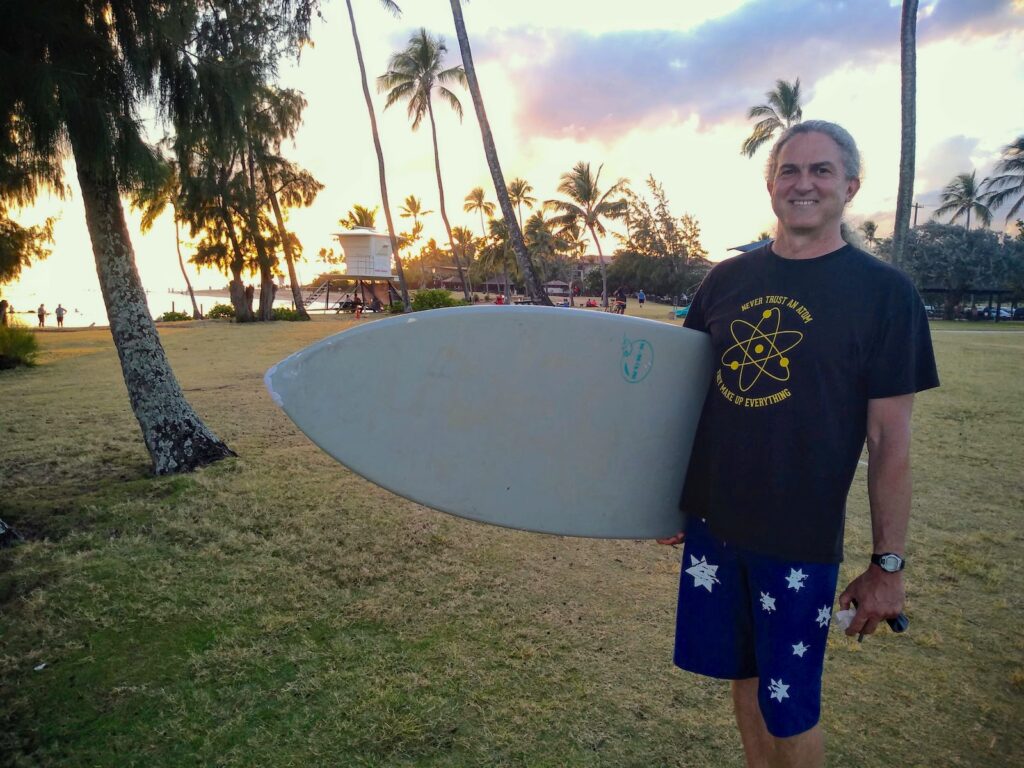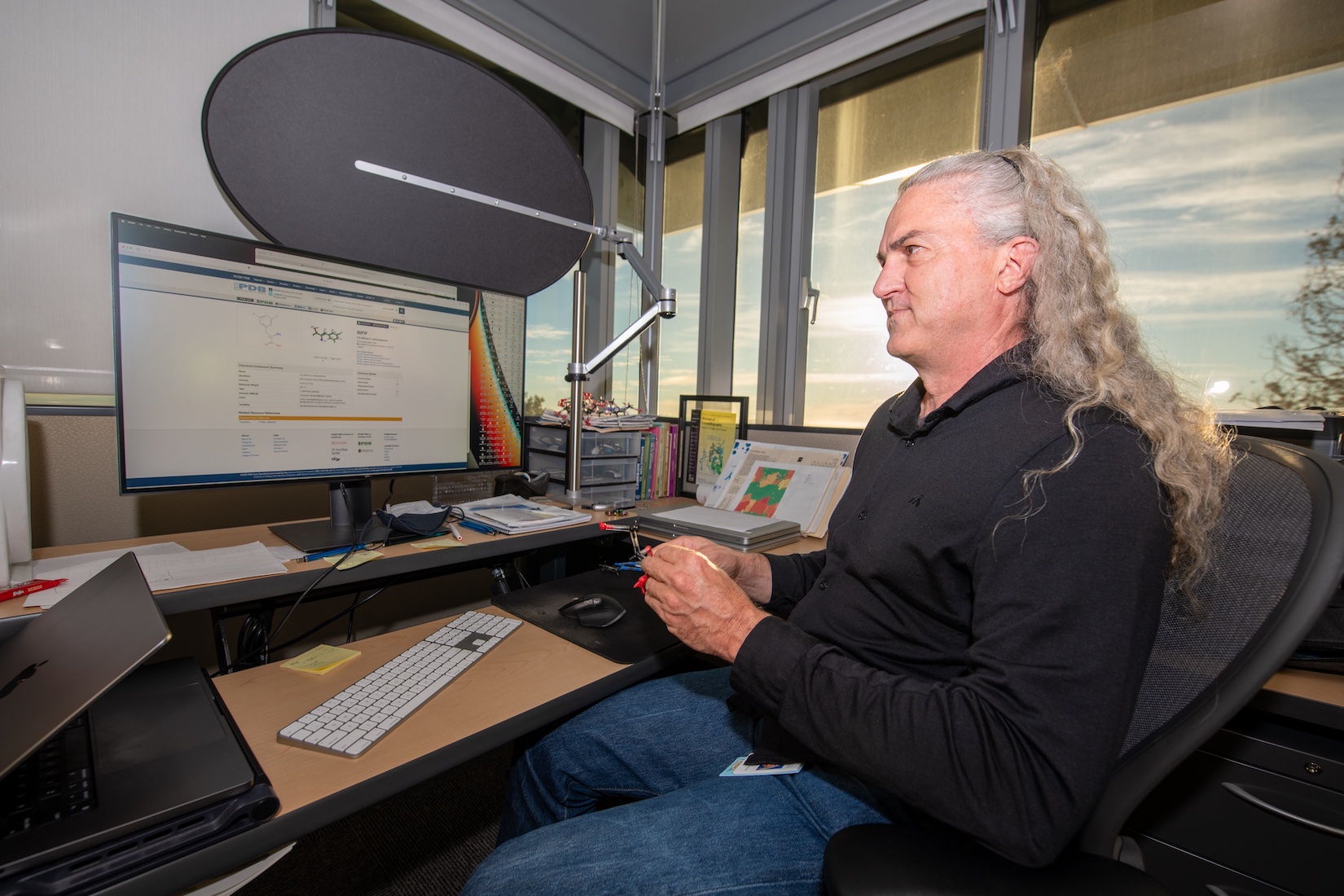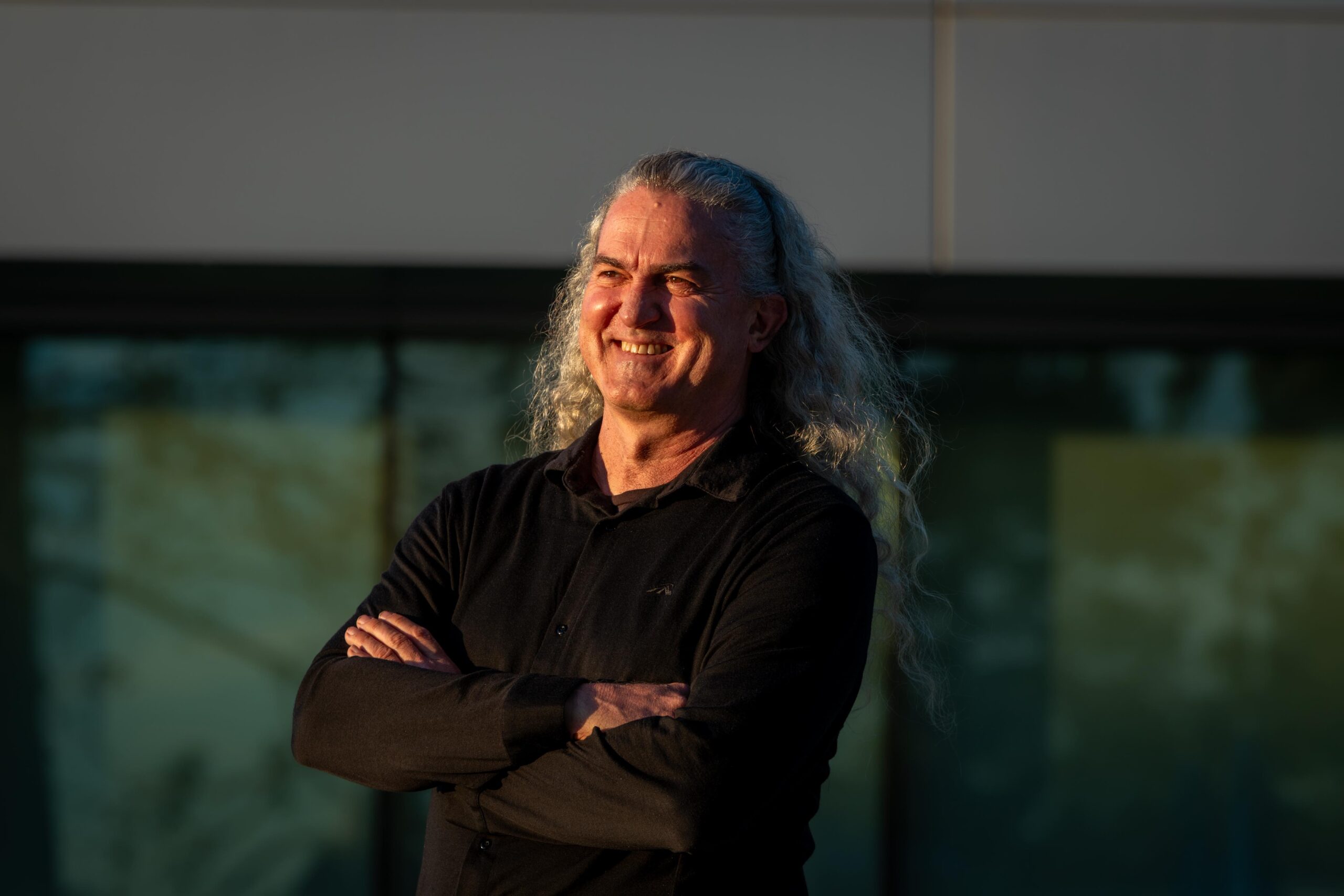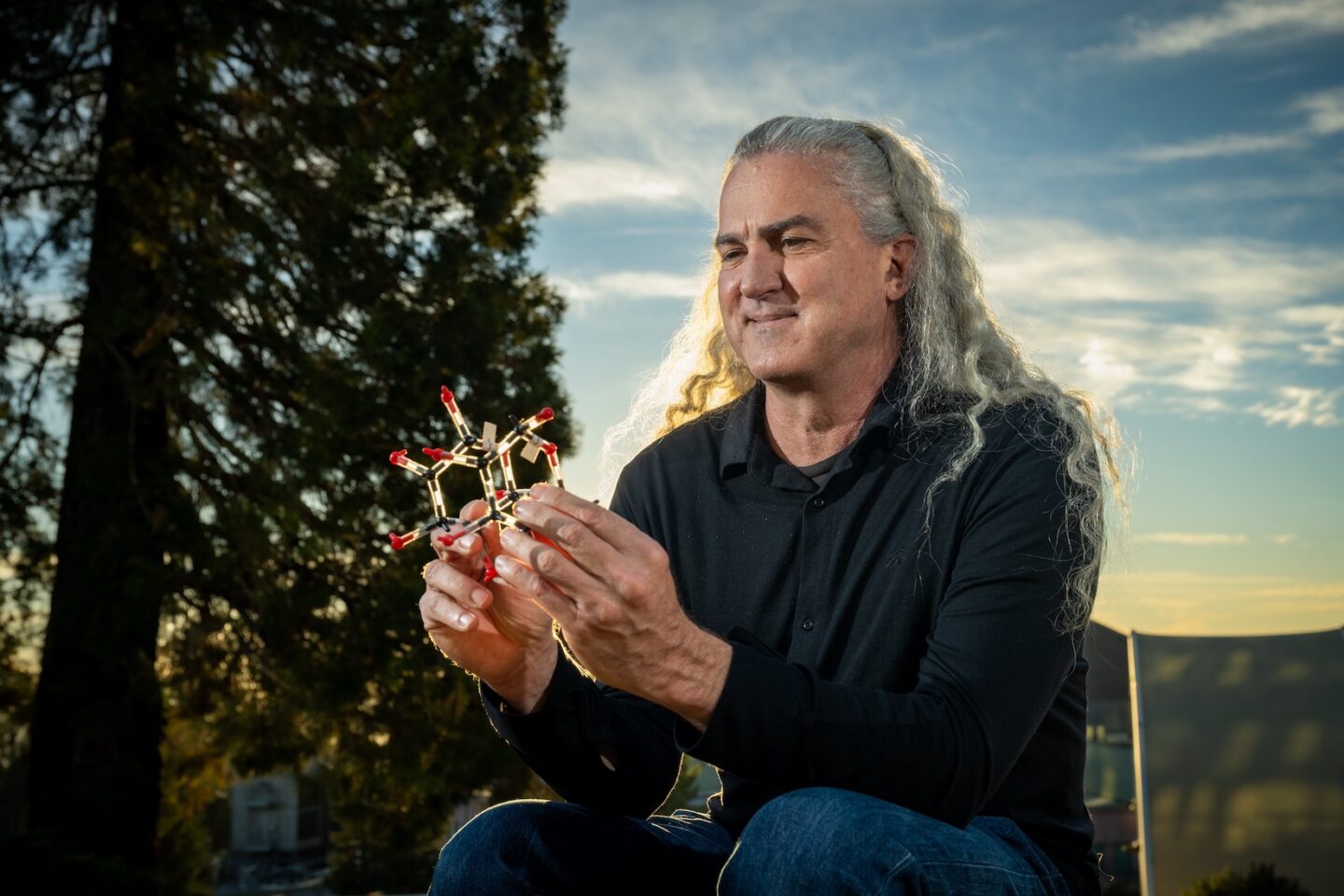On a recent surf trip to Hawaii, Nigel Moriarty recalibrated his fin setup and, to his delight, unlocked a boost of speed. Experimenting with fin number, stiffness, and arrangement is a common way surfers customize their boards to adapt in changing conditions—and Moriarty is more interested in the underlying physics than most. “There’s a compromise between going fast and maintaining maneuverability. My setup was too slow to make the wave sections before they crashed on me, so I adjusted the board speed to suit the location and dealt with the reduced flexibility,” he said. “After that it felt like I was going twice as fast, even if it was actually only twenty percent faster.”
A computational research scientist in the Molecular Biophysics and Integrated Bioimaging (MBIB) Division’s PHENIX group for over 23 years, Moriarty is well-versed on the interplay between theory and experimentation. Researchers from around the world use crystallography beamlines at the Advanced Light Source to study macromolecular structures on an atomic scale, and apply PHENIX software designed to determine the most comprehensive picture from the beamline data. Using principles from theoretical chemistry and physics, such as the chemical features of various amino acids and the flexibility and energetic potentials of different bonds, the software generates realistic computer models of how molecules will behave in dynamic systems. “The model guides the experiment and the experiment guides the model,” said Moriarty. “They interact to lead to the best answer.”
Iteration is not just a keystone of Moriarty’s everyday work, but crops up repeatedly throughout his winding career journey and multifaceted personal life. His penchant for learning propelled him across three continents, four scientific disciplines, and countless disparate pockets of society: from electrical workers to stamp collecting aficionados and surfing daredevils.
Carving a Smooth Path
In the small country village in northeastern Australia where he grew up, Moriarty’s propensity for math and science stood out, carrying him through high school physics and math classes, a four-year electrician apprenticeship, and a Bachelors of Education in physics and mathematics at Avondale College. Prompted by his mentor at Avondale, Moriarty enrolled for an additional year at the more prestigious Newcastle University in New South Wales to complete a postgraduate honors Bachelor of Science degree.
While advanced calculations and scientific concepts seemed to be hardwired for Moriarty, not all aspects of scientific practice were. He recalled an organic chemistry lab assignment to assemble pieces of glassware into an apparatus for distilling various substances. “I kept dropping glass on the ground and breaking things,” he said. “And I thought, maybe I’m not cut out for the lab.” That, plus grueling hours spent at the bench to get the details of his experiments just right, convinced him that wet lab work was “not his cup of tea.”
So Moriarty pivoted. He turned his attention to theoretical physics, which allowed him to focus on mathematical models and abstractions for explaining and predicting natural phenomena rather than wet-lab experiments. In his undergraduate research, he used computer programming to calculate the detailed chemistry for making silicon semiconductor surfaces. Computers were just emerging at the time, and having a personal machine was a rarity. As Moriarty began coding, he marveled at the endless possibilities that opened up when writing programs to control these strange devices: He could get them to do all sorts of simple things very quickly, or embark on very complicated things that previously seemed impossible.
“My PhD supervisor wrote his dissertation using a slide rule. A couple of years later, the whole thing took about .2 seconds to do on a new university computer,” said Moriarty. “I was always joking with my mother-in-law because I would be sitting on her couch while my computers did things for me, whereas she had to go out and do her botany field work. That was all very exciting to me, and still is.”

Theoretical physics wasn’t the only interest Moriarty picked up while studying at Newcastle. The coastal environment offered a chance at a thrilling new passion: surfing. “I did all sorts of strange and crazy things with my friends while I was learning, like going on safaris to the places where the big waves were. Some of our best times were taking off on huge waves, with everybody else there yelling and screaming,” Moriarty said. “There’s a satisfaction in being able to catch a challenging wave, and I really enjoy the rush and speed.”
Precision Maneuvers
When he graduated from Newcastle, the same trusted mentor urged him to pursue a PhD. He began a theoretical chemistry doctorate at the University of New South Wales, where he worked on calculating computational models for transition metals and their quantum mechanics. Moriarty was pulled in by the precision of quantum chemistry. “With enough computing power and time, you can calculate the wave function and know everything you need to know about a certain molecule,” he said. “It’s a little like magic.”
Moriarty then accepted a postdoc position in Sweden investigating the molecular structure of water through the lens of quantum mechanics. But a downturn in interest for quantum chemistry caused him to switch stance again, and he pursued a second postdoc, this time in UC Berkeley’s mechanical engineering department, researching how to limit the pollution from diesel combustion.
When a research scientist position opened in the PHENIX group at Berkeley Lab, Moriarty seized the opportunity to revisit his interest in quantum physics and chemistry and apply it to a new field: drug design. Quantum-precise molecular models enable more accurate predictions about how drugs will bind with proteins, or how their structures could be modified to become more effective, without the need for time-consuming experiments.

Though his day-to-day work is primarily fixing bugs and building new features for the PHENIX software suite, he also uses his molecular modeling expertise to buoy other Berkeley Lab research projects. A recent collaboration integrating X-ray crystallography snapshots of photosystem II obtained by the Yano/Yachandra/Kern group with computer modeling helped reveal an elusive step in photosynthesis. Moriarty was also recognized for his work building a dynamic computer model of the Covid-19 spike protein that included precise information about the molecules’ chemistry, like bond lengths and angles. “I wiggled it, basically, and said, here are 700 different ways that the spike protein can move. Where could a drug get in to bind it?”
Subculture Surfing
Moriarty earned his position in scientific circles slowly, through decades of training and committing his talents to impactful, collaborative projects. But in the surfing world, Moriarty remakes himself every time he paddles out on the open ocean. He must choose whether to earn the respect of the other surfers on the water by taking on the biggest wave, or follow the lead of whoever is reigning top dog. “If you look like a tourist and just showed up yesterday, that can work against you,” he said. “It’s a completely different way of looking at life and your social interactions. I enjoy taking almost an anthropologist’s point of view; thinking about how these things develop and become what they are.”

This stamp set is of particular interest to Moriarty, and is said to be the world’s first omnibus issue—stamps issued by several countries with a common subject which may share a uniform design. The set was produced in 1898 by Portugal and Colonies to commemorate the 400th anniversary of Vasco de Gama’s discovery of the sea route from Europe to India. The bottom two stamps are examples of designs that differ from the set of eight above. (Courtesy of N. Moriarty)
Stamp collecting, or philately, is another community Moriarty has observed from the inside. It was not an uncommon story for a kid growing up in the sixties: Moriarty’s mother gifted him his first stamp collecting album at the age of six. While the colorful graphics may have been the initially appealing factor, he soon came to appreciate the sense of organization and accomplishment. “People think it’s just taking stamps and putting them into an album, but there’s actually a lot of research that goes into it,” he said. Much like the rush from catching a big wave, Moriarty savors the chase and satisfaction of tracking down rare items that nobody else knows about. He also loves studying history to learn how and why a set of stamps was produced. “Stamps don’t just appear; someone has to design them. So it’s about finding the original artwork design and any test prints that were made, often in different colors.” For several years now he’s been assembling all the components and accompanying history for a Portuguese set from 1898. The remaining items are out of his price range, so for now, the gratification of completion will have to wait.

After a brief hiatus as a young adult, Moriarty’s hobby reemerged upon moving to the Bay Area, an established hotbed of philately. Moriarty now volunteers and serves on the board for Westpex, an annual gathering first held in 1960 where stamp collectors and dealers from all over the world show, buy, sell, and talk to fellow enthusiasts.
Science, surfing, stamps, and the blue collar culture he brushed shoulders with during his electrician apprenticeship are just a sampling of the many distinct communities Moriarty has dipped toes in. Varied experiences with different types of people help him maintain a healthy work-life balance and inspire him to be more self-aware. “I try to look at my attitudes and what’s driving things,” he said. “You realize that you could be wrong about something.”
Building towards Quantum Leaps
Moriarty’s day-to-day work is generally geared towards PHENIX’s users: academics, pharmaceutical company researchers, and other commercial customers. “It’s being applied in real time, and people have a vested interest in whether the software works or not. So we have to take a professional, long-sighted approach to our code.”
This interface with industry puts the PHENIX group in a slightly different position than many research labs. But while his work is, at its core, a real-world application of theoretical science, in other ways Moriarty feels he’s paddling far upstream from the major impacts people recognize and understand.
“I get asked all the time: are you working on a cure for Alzheimer’s disease? They think medical applications straightaway,” he said.

Moriarty does his best to explain that he’s playing one small part in a much broader story. And being a self-described cog in the machine does not detract from his passion. He’s found a niche for applying his deep theoretical knowledge in a way that changes lives: At least half a dozen different drugs that are now on the market were developed using PHENIX software.
“I’m doing a very specific thing, and I try to do it as well as I can… I try to do it in a way that makes it easier and quicker to develop new methods so that other people can make huge breakthroughs.” ⬢
Written by Maritte O’Gallagher. As a communications specialist for Berkeley Lab’s Biosciences Area, O’Gallagher spotlights the people and stories behind our latest research.
Read other profiles in the Behind the Breakthroughs series.




